August: The Prairie Is Waving
Frontenac State Park Association newsletter
Vol. 1, No. 5, August 2023

Black-eyed Susans (Rudbeckia hirta; native) and Queen Anne’s lace (Daucus carota; non-native) brighten the prairie landscape. / Photo by Pamela Miller
August: The prairie is waving
For lovers of prairie, August is an exhilarating month at Frontenac State Park. In the prairie landscapes that grace much of the lower park and part of the upper, native grasses top 6 feet in late summer. On a breezy day, they and robust wildflowers sway in the warm wind, their graceful waves bringing to mind a land ocean. Walking along the mowed paths, you feel like you’re moving through nature’s labyrinth.
And oh, so many native prairie plants you’ll see along the way! Look for little bluestem grass, Indian grass, sideoats grama, Canada wild rye, asters, black-eyed Susans, blazing stars, butterfly weed, common sunflowers, compass plant, coneflowers, Culver’s root, fleabane, goldenrod, hoary verbena, leadplant, milkweed, motherwort, pearly everlasting, prairie clover, rattlesnake master, compass plant, tick trefoil, white sage, wild bergamot and wild indigo.
You’ll also see several pretty but potentially problematic nonnative plants. Exhibit A: Queen Anne’s lace – hint, hint, it’s named after an English queen! Invasives, however, are complicated – some are less relentless and intrusive than others. Some are just opportunistic. Some are … quite pretty! Yes, friends – it’s complicated out there.
This month, we’re highlighting our priceless-for-science (and also fun!) Aug. 19 bioblitz, the grace of American White Pelicans, a dramatic and frankly gruesome spider-bee encounter, and fascinating facts about frogs and toads. Read on!
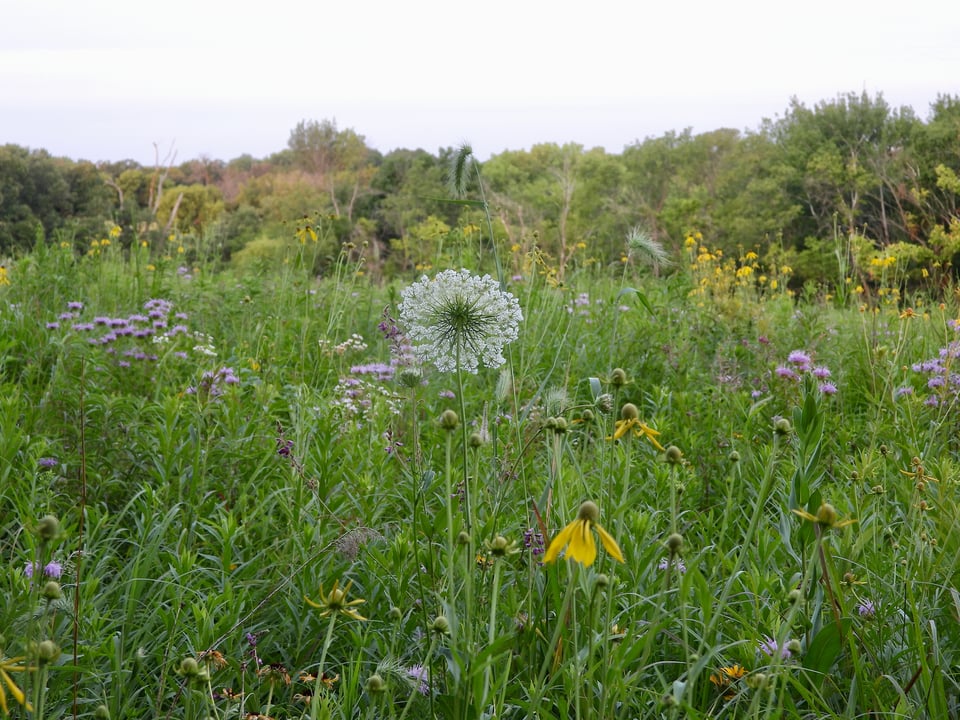
Wild bergamot (Monarda fistulosa), Queen Anne’s lace (Daucus carota) and prairie coneflowers (Ratibida columnifera) along a Frontenac State Park prairie path. / Photo by Steve Dietz
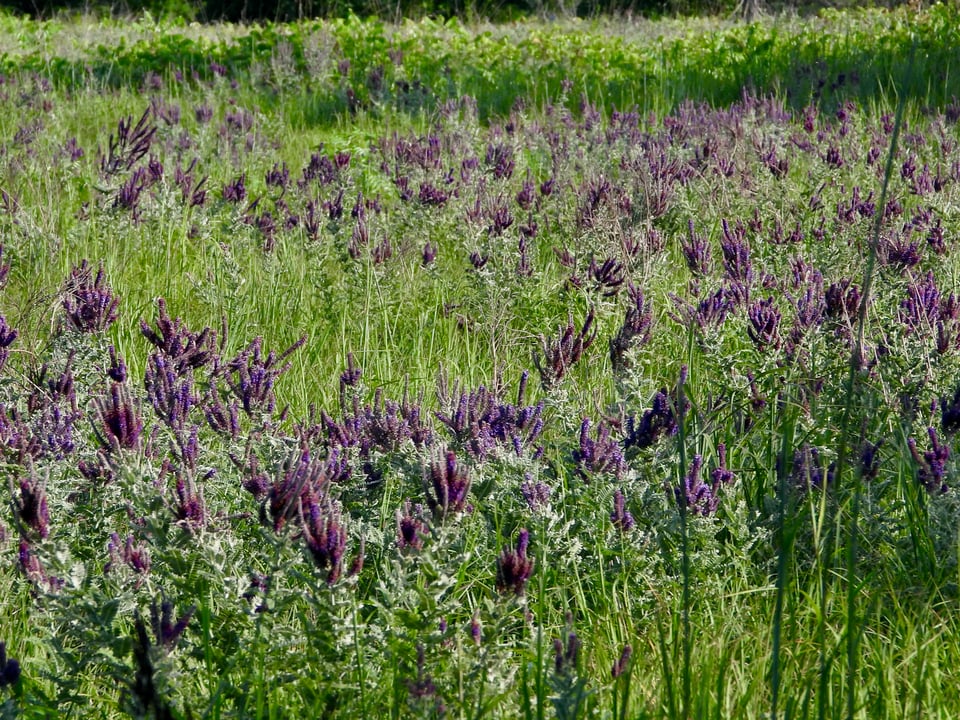
The deep roots of leadplant (Amorpha canescens) help it survive fires, natural or prescribed. / Photo by Steve Dietz
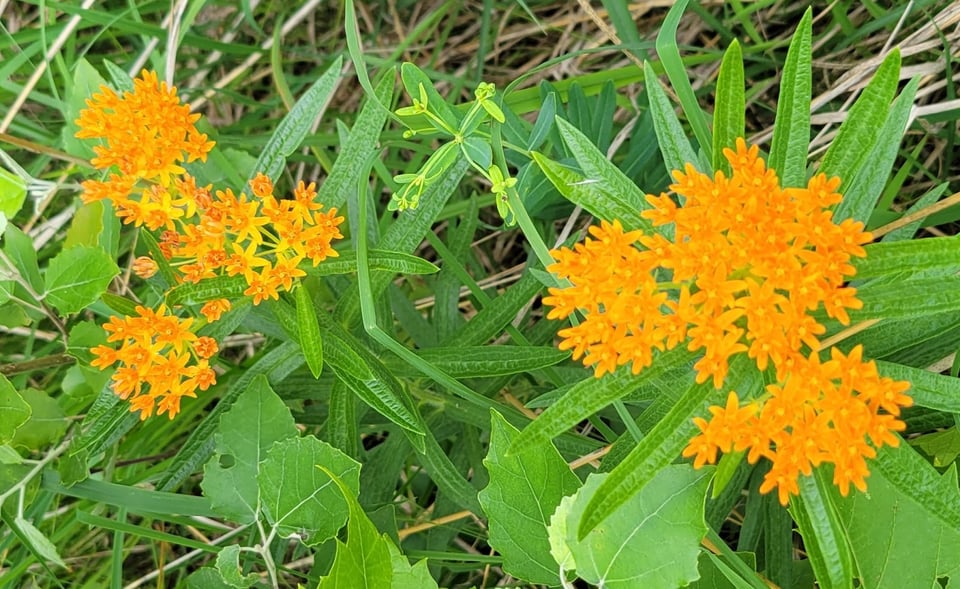
Butterfly weed (Asclepias tuberosa) is a lovely bright orange, just like the monarch butterflies it serves as a host plant. / Photo by Pamela Miller
August events: Join us for our annual bioblitz
It’s time for our annual bioblitz! Nature lovers, we need your help – join your friends in the Frontenac State Park Association from 9 a.m. to 1 p.m. Saturday, Aug. 19, to help find and record various species of flora and fauna in Frontenac State Park.
What’s a bioblitz, you ask? It’s a citizen-science group effort that focuses on finding and identifying as many species as possible of plants, animals and insects – the biota – in a specific area over a short period of time. Another name for a bioblitz is a biological census or survey.
A bioblitz is a fun way to learn more about the flora and fauna in our park from knowledgeable guides, as well as to contribute to our understanding of current conditions in the park, which helps it plan for the future.
Aug. 19 will go like this: Meet at 9 a.m. in the parking lot near the park’s signature overlook to hear more about the walks we’re offering that day and to decide which one to join. These guided walks (listed below) will visit different areas of the park to identify species in various genera. Then, at noon, we’ll all regroup at the picnic shelter by the parking lot to discuss our findings. Snacks will be provided.
There’s no need to pre-register for the bioblitz. Just show up dressed for the weather, with sensible walking shoes, water, bug spray, and a notebook and pen to record your sightings. Bring a camera and your phone (with the iNaturalist app loaded, if you want, but it’s not mandatory).
Walks will last approximately 2½ hours, but you can leave anytime if you need to. All walks are family-friendly.
Here are the walks we’ll offer. All start at 9 a.m.:
Bird walk with Janet Malotky, Master Naturalist. Meet at the picnic shelter near the park’s main overlook.
Butterfly walk with Sandy Hokanson, who leads bird and butterfly walks with the Zumbro Valley Audubon Society. Meet at the picnic shelter for an overview, then travel to park headquarters and walk the prairie loop.
Fungi walk with Pamela Miller, Master Naturalist. Meet at the picnic shelter for an overview, then travel to a wooded path for our walk.
Plant walk with Jeneann Oppedahl, Master Naturalist, and Park Ranger Jake Gaster. Meet at the picnic shelter, then walk along the blufftop trails.
Tree walk with park employees Kathy Gates and Amy Poss. Meet at the picnic shelter and walk along the bluff top.
And don’t forget…
Not to leave out the park’s regular Saturday nature walk…
As always on summer Saturdays, interpretive naturalist Bruce Ause will lead his delightful, thoughtful nature walk from the campground shower building starting at 10 a.m. Family-friendly, lasting about an hour, on a trail of gentle slopes in prairie and woods. Highlights of the walk will be presented at the noon roundup of the bioblitz.
Even before our bioblitz, there will be a bird walk at 8 a.m. Saturday, Aug. 5. Meet at the Ranger Station parking lot. We’ll travel along mixed prairie and forest trails to the Pine Loop and back, hoping to see a wide variety of forest- and prairie-dwelling birds. Bring binoculars. The mowed trail is well maintained and traverses some elevation changes. The full route is about 2 miles. When birding, this can take about 2 hours depending upon how many birds we see, but you can leave whenever you like. No need to register, but if you have any questions, email janetmalotky@gmail.com.
Bird notes: The grace of American White Pelicans
By Janet Malotky, Master Naturalist and FSPA member
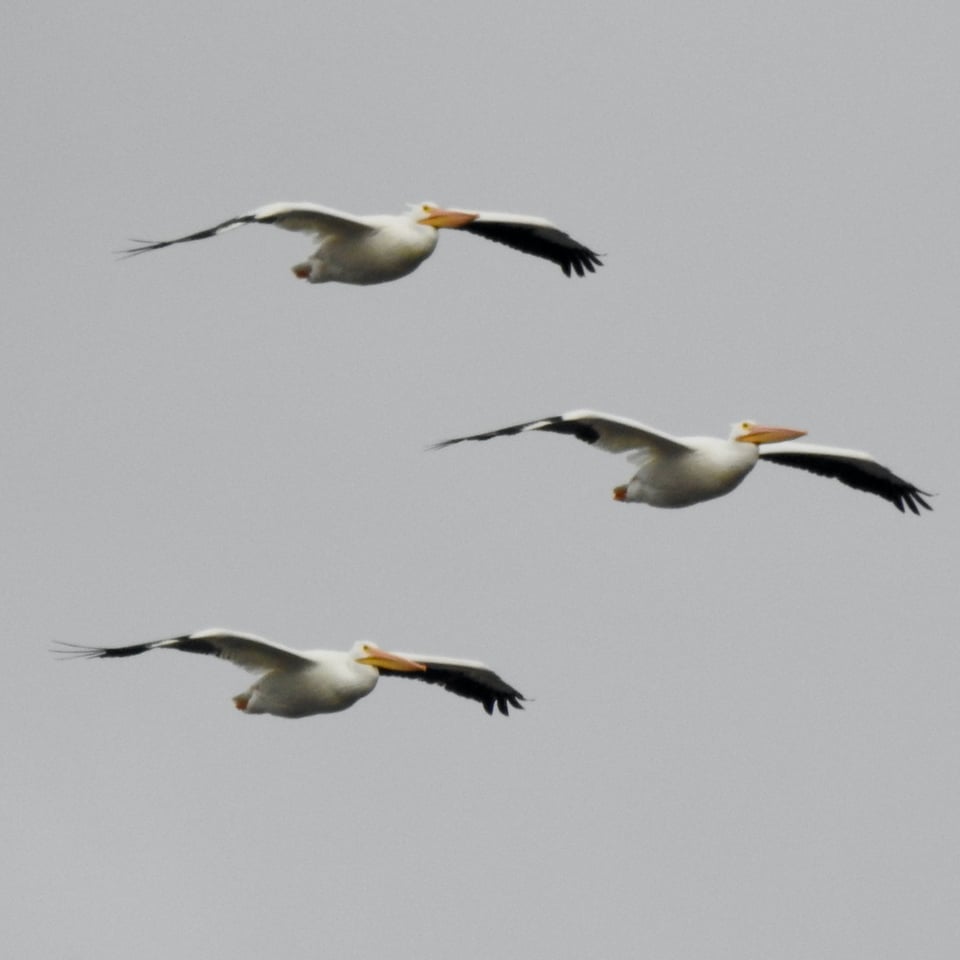
A detachment of American White Pelicans coming in for a landing near Sand Point. / Photo by Steve Dietz
High overhead, a squadron of American White Pelicans circles in slow descent toward the water. They wheel as one, disappearing against the brightness of the sky, then flashing white as the sun strikes their synchronous arc.
Over and over, the flock disappears, then flashes, disappears, flashes, their black wing-tips and edges steady, their long necks and legs tucked.
When they reach the water, the pelicans ski in on big webbed feet, ruffle their feathers, and begin to swim, gliding as smoothly as their flight was steady, with no register of the commotion of their paddling below.
Pelicans sometimes fish alone, all out for themselves, even stealing fish from their neighbors. I’ve seen a pelican steal a fish from a Bald Eagle.
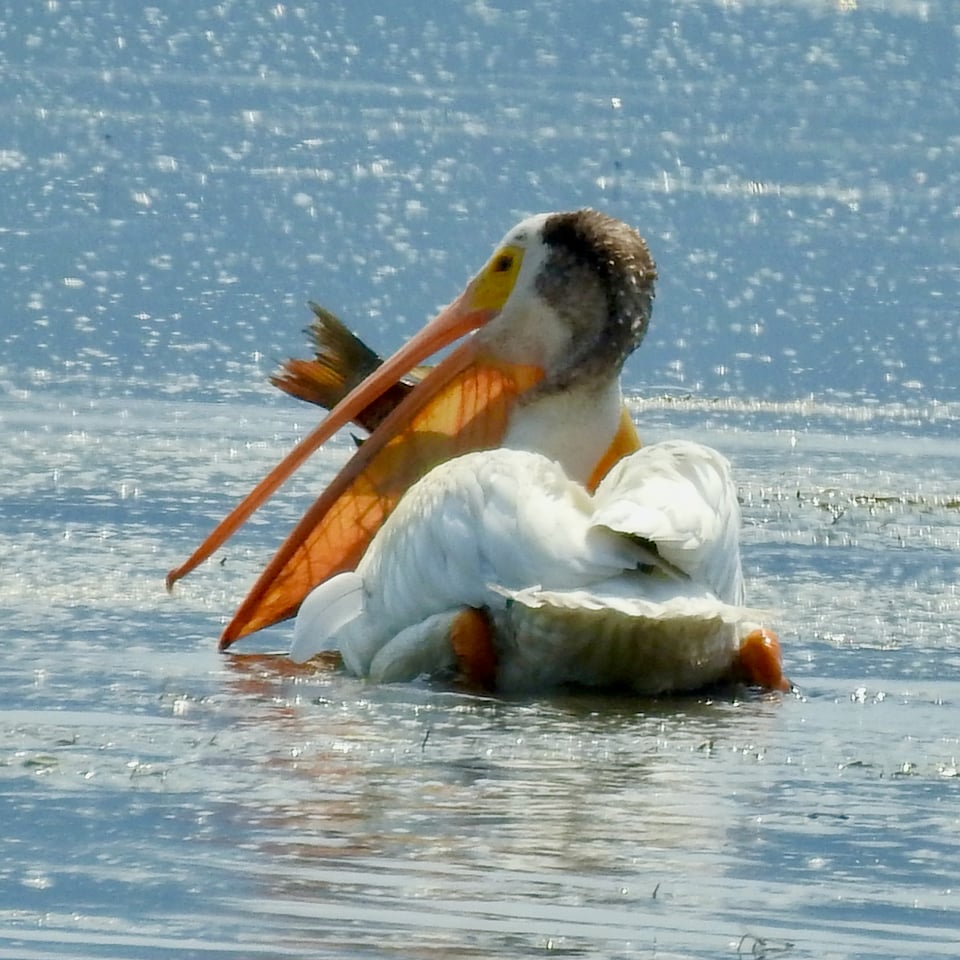
Good fishing. / Photo by Steve Dietz
But now, the flock clumps tightly together and begins to fish cooperatively. They paddle in strict unison, forming a dense line and then an arc, corralling the small fishes below into shallower water. Their huge bills dip, scoop, and swallow, spilling excess water out the sides and gulping any trapped fish whole.
Pelicans make growly sounds, but they are more often seen than heard. They are big birds, able to swallow large fish, but they also eat salamanders and frogs. More numerous in our area during migration, they can nevertheless be seen in and over Frontenac State Park in midsummer as well. They winter in U.S. coastal waters, but nest on inland lakes north and west, as close as far western Minnesota.
Nesting on gravelly ground, they lay two eggs. Most often, only one chick survives, as they take sibling rivalry to a fatal conclusion in a behavior known as siblicide.
Pelicans fish day and night. It’s a lucky person who happens to be gazing across the water when a pelican, brightly lit by the moon and shining white, glides silently through the darkness, followed by another, then another, ghostly denizens of the night. We can thank the Mississippi River for their presence in our area, but pelicans can also be seen in our own Pleasant Valley Lakelet at times, as they are dabblers, not divers, and need to fish in shallow water.
If you’re looking for them in the park, the Sand Point Trail is usually the best place to spot them hanging out in the sun with the gulls and terns at the very tip of the point, enjoying the river.
Grassland birds we’ve seen lately…

A Sedge Wren sings its busy little heart out. / Photo by Steve Dietz
Every Frontenac State Park walk presents us with an exciting list of birds that nest in the park. Here’s a few spotted recently on the prairie portions of the park’s Rattlesnake Bluff trail.
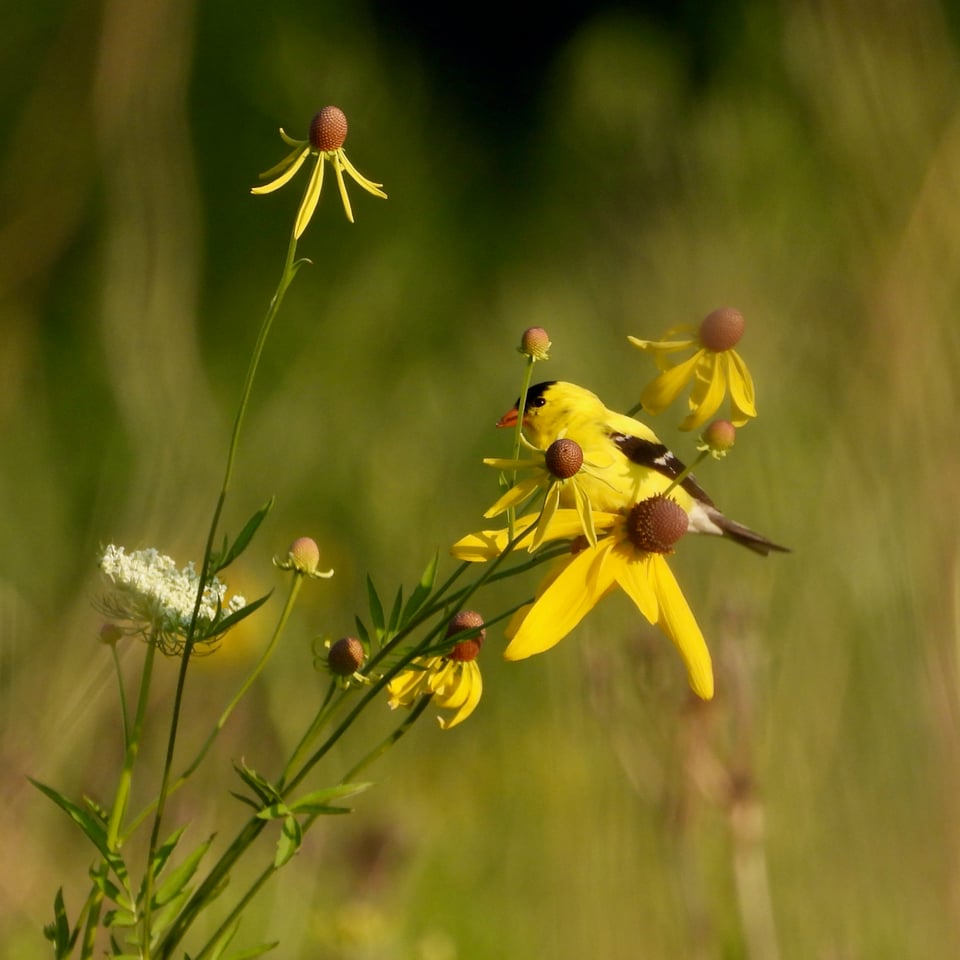
An American Goldfinch graces a prairie coneflower. / Photo by Steve Dietz
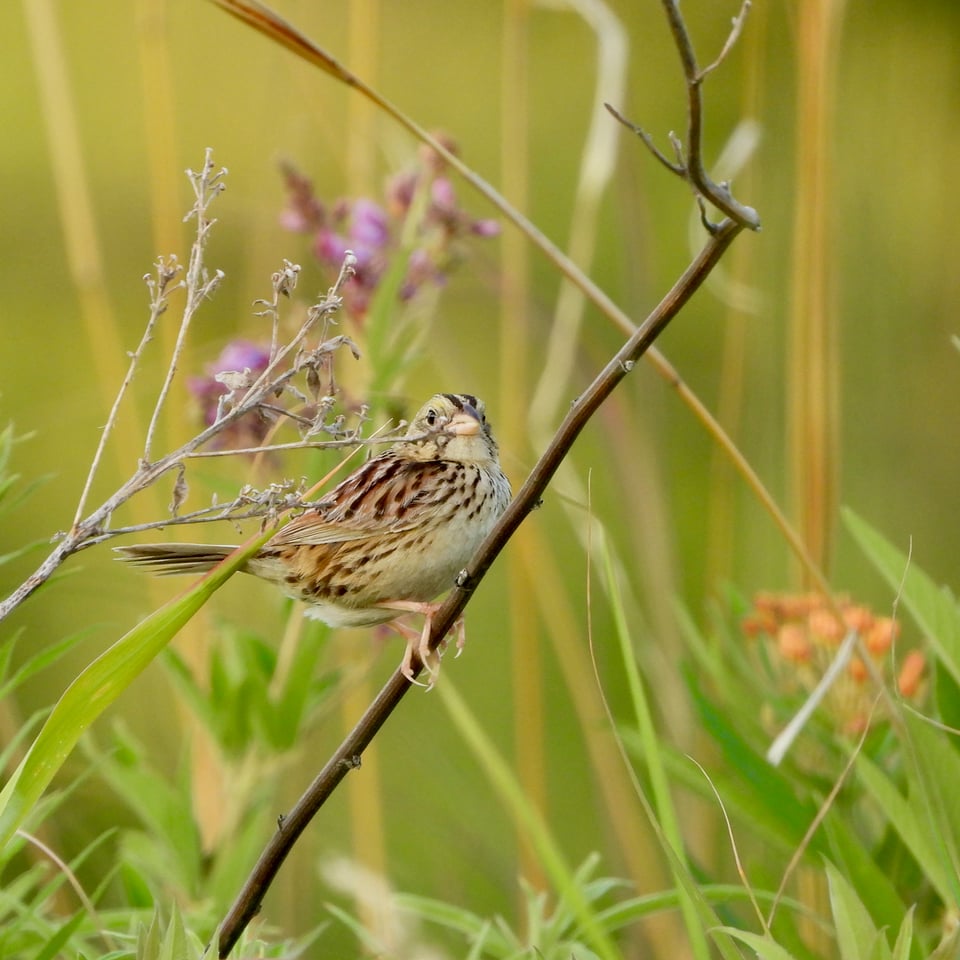
An exciting sight! A Henslow’s Sparrow – a bird that’s listed as endangered in Minnesota – goes about its business in a remote part of the park. / Photo by Steve Dietz
Notes from the field: Isn’t evolution grand?
By Steve Dietz, Master Naturalist and FSPA president
Warning: Parts of this little nature story may be disgusting to some humans.
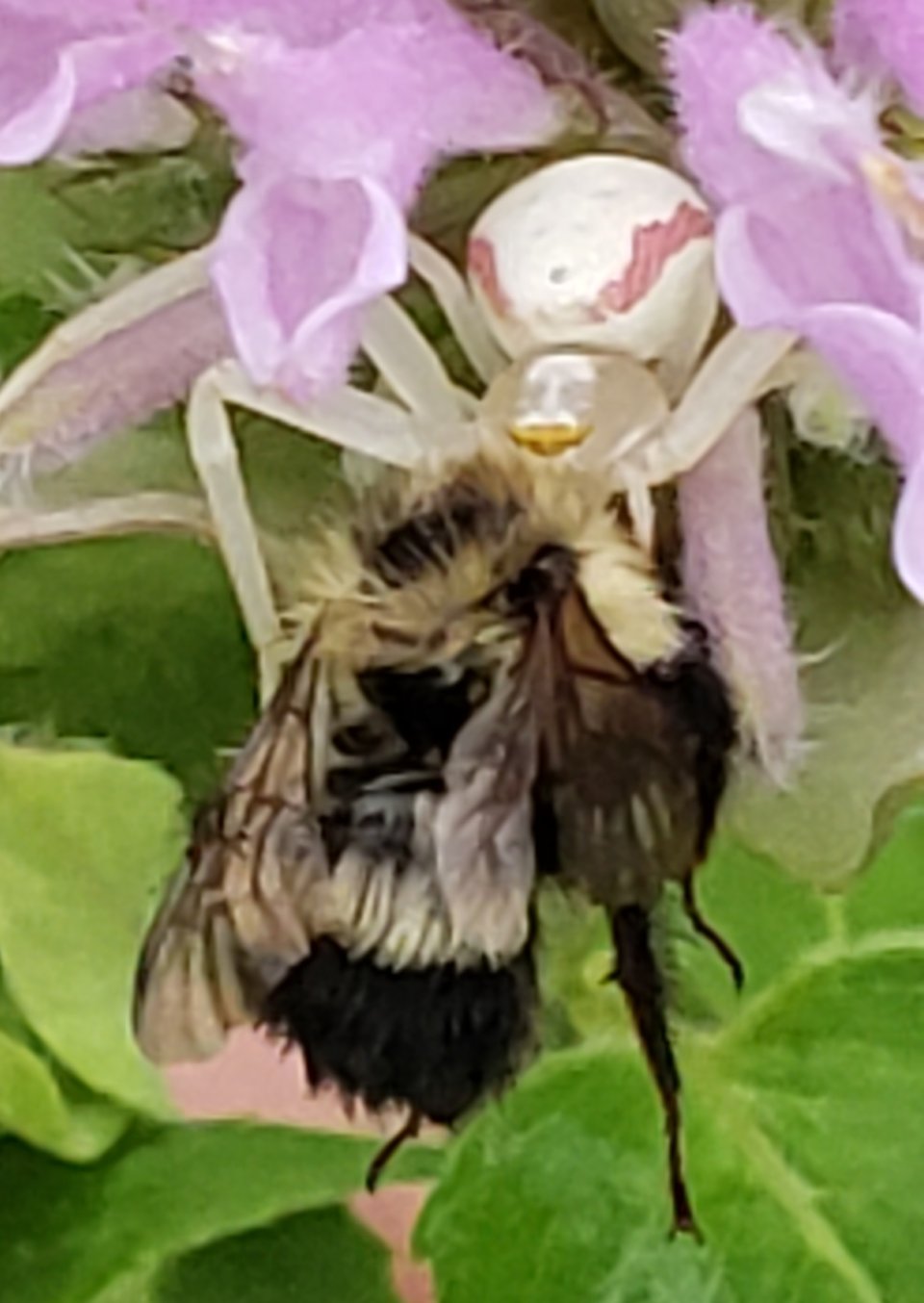
A goldenrod crab spider makes short work of a bumblebee. / Photo by Steve Dietz
The goldenrod crab spider (Misumena vatia) is so-named for lurking in goldenrods and other pollinator plants. It has the unique ability to walk sideways as well as forwards and backwards, like a crab. It usually has a yellow pattern on a white body, but can change color through the molting process to green or pink, depending on its surroundings. The color of the wild bergamot in the photo above may have influenced its color there.
The spider, camouflaged in a flower, waits for often much larger prey such as the (dead at this point) bumblebee in this picture to visit the flower. It then uses venom to immobilize the prey, and with its fangs injects it with digestive enzymes before sucking out the rendered bodily liquids.
This is a form of external digestion. As a result, prey size is not a limiting factor for consumption. Sometimes, the female uses her venom to kill her mate during copulation, especially after mid-July. (Source: iNaturalist)
Special feature: Frogs and toads, oh my!
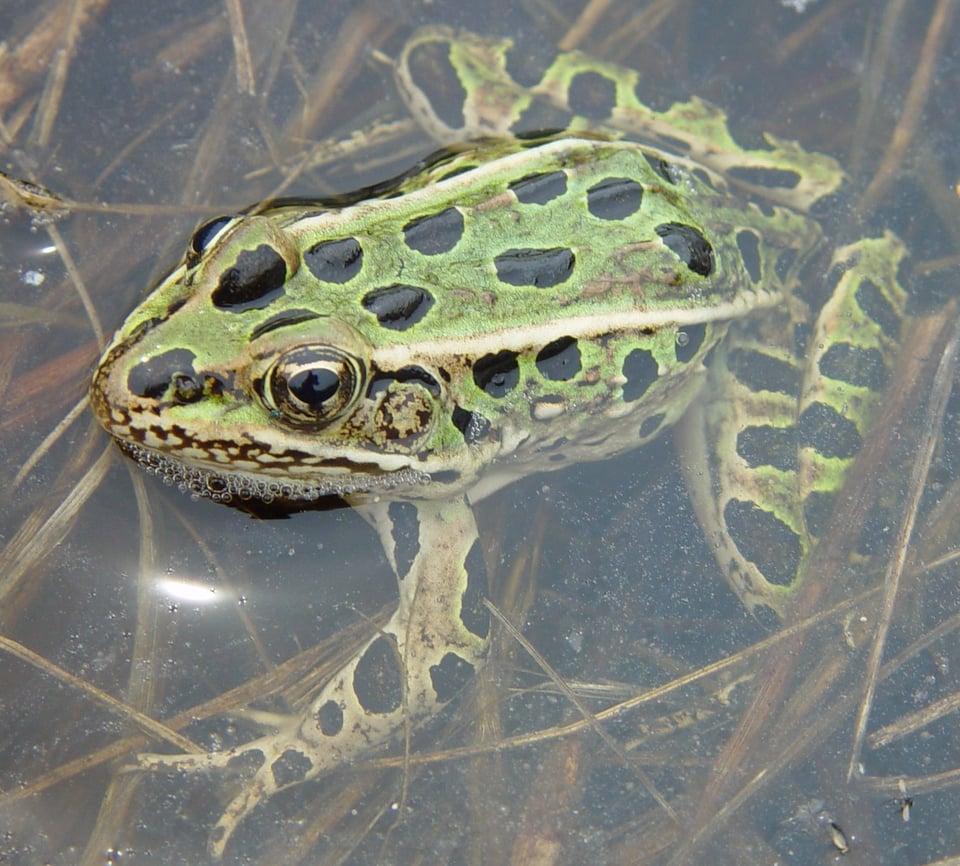
A Northern leopard frog. If it’s wet enough, you’ll see lots of these pretty little frogs hopping around on the Sand Point Trail. / Photo by Carol Hall, Minnesota DNR
By Pamela Miller, Master Naturalist and newsletter editor
Frogs and toads often fly under the radar, sometimes startling us, sometimes delighting us, when they hop into view. Friends! They’re so important to the ecosystem, and there’s so much to know about them! To that end, we are honored and delighted to present this Q&A interview with Carol D. Hall, a herpetologist with the Minnesota Department of Natural Resources’ Minnesota Biological Survey.

Q: Tell us a little about your life, and about what drew you to herpetology.
A: Ever since I can remember, I was fascinated by our natural world. I love learning how things are connected and where they fit into the landscape. I feel very fortunate to be working with a knowledgeable group of people in the Minnesota Department of Natural Resources who are dedicated to surveying and protecting these resources in Minnesota.
I grew up in Brooklyn Center and completed my Bachelor of Science degree in wildlife management and biology at the University of Wisconsin-Stevens Point. Several years later, after many temporary jobs in resource management, I earned a master’s degree in wildlife conservation at the University of Minnesota. My research involved conservation and management of Blanding’s turtle, a threatened species in Minnesota. This led to my current position – herpetologist with the Minnesota Biological Survey – which I’ve had for more than 30 years.
When I’m not in the field conducting surveys, I’m often gardening! I welcome treefrogs and toads into my vegetable garden and prairie patch. They breed in my small constructed pond, and I think of them as my version of biological pest control. My prairie patch also welcomes snakes and lizards, with logs and flat rocks scattered about to provide cover.
Q: Minnesota has 14 species of toads, frogs and treefrogs. What are the chief differences among those three groups?
A: Toads: A toad’s skin is thick, dry and warty, enabling it to tolerate dry environments. Toad skin glands have secretions that make them unappetizing to most predators. Toads do not cause warts, but if you handle one, its skin secretions can be irritating if you rub your eyes. Toads have short, stout bodies and stubby legs that cause them to hop instead of leap like frogs. Adult toads typically breed in shallow water, which warms quickly, hastening tadpole development. Female toads lay thousands of eggs in long strings attached to vegetation. Toad tadpoles transform more quickly and at a smaller size than frogs. Tiny toadlets can be quite abundant as the former tadpoles transform and emerge from shallow ponds into forests and fields.
True frogs: This is a group of long-legged, narrow-waisted, smooth-skinned frogs. Adults are typically larger than toads and tree frogs. Males call while floating or sitting in water. Many species lay eggs in a film on the surface of the water, while others lay eggs in large clumps attached to vegetation. Tadpoles of true frogs may take two or more years to transform into adults.
Treefrogs: Treefrogs are considerably smaller than toads or true frogs. All treefrogs have toe pads, though they vary in size among the species. Species with large toe pads can climb high into trees to feed. During the breeding season, males call from perches on vegetation in or near standing water. Female treefrogs lay eggs singly or in small clusters, attaching them to aquatic vegetation.
Q: What toads and frogs are we most likely to spot in Frontenac State Park, and in what areas?
A: Common species likely to be found in the park include the following:
American Toads: In grasslands and open woodlands.
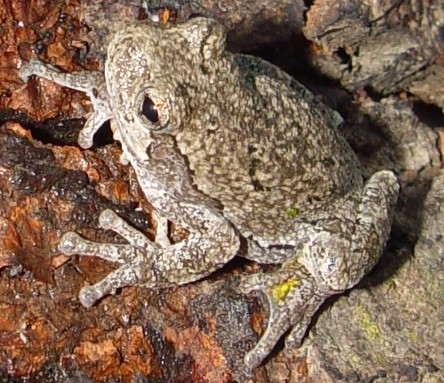
A Gray Treefrog. / Photo by Carol Hall, Minnesota DNR
Gray Treefrogs/Cope’s Gray Treefrogs: Both species could be present in the park. They look quite similar and the easiest way to identify them is by listening to their breeding call. They can be found in woodland and shrubland habitats.
Boreal Chorus Frogs: Grasslands.
Green Frogs: Within or along the edge of an aquatic habitat (river, stream, lake, pond).
Northern Leopard Frogs: Grasslands. (Also, this may be the species often seen along the Sand Point Trail. They can be abundant when the year’s young emerge from breeding ponds.)
The Minnesota Department of Natural Resources would like more information about the distribution of these species in Goodhue County:
Spring Peepers: This species is common in forests of northern and central Minnesota. Although records exist for Goodhue County, they are quite dated. If Spring Peepers are present in the park, they would be found in mature woodland habitat where shallow, fishless seasonal ponds occur.
Blanchard’s Cricket Frog: Goodhue County lacks a record for this endangered species. However, it is known to occur along the Mississippi River, upstream in Dakota County and further downstream.
Q: What frogs do we hear singing from the trees on these lovely long nights?
A: Treefrogs are adapted for climbing and often produce short calls from unexpected places during their active season. You may hear them calling from a tree canopy, from between boards on a deck, or even from under a pool cover or grill lid. Their toe pads enable them to climb where they can forage on insects and take shelter in moist, protected areas such as a tree cavity.
Q: How do toads and frogs survive the winter?
A: In Minnesota, toads and frogs overwinter in one of three ways:
-
Submerged in a well-oxygenated lake, pond or river (for instance, Green Frogs and Northern Leopard Frogs. This also includes tadpoles of some species).
-
Underground where they are able to burrow below the frostline (for example, the American Toad).
-
Under a log or leaf litter where their bodies tolerate freezing temperatures by creating an alcohol that acts as an antifreeze that protects their vital organs (for example, Gray Treefrogs, Wood Frogs).

A Wood Frog near an egg mass. / Photo by Carol Hall, Minnesota DNR
Q: What do toads and frogs eat?
A: As tadpoles, most species native to Minnesota feed on algae and decomposing vegetation. When they’re adults, invertebrates provide a major part of their diet. Larger individuals, such as bullfrogs and Green Frogs, will feed on other vertebrates as well, such as small snakes and mice. Their place in the food web also includes a prominent role as prey to other species.
Q: What does the study of frogs and toads in all stages of their lives tell us about the environment, habitat, climate change?
A: Frogs and toads are amphibians, meaning they live a dual life utilizing aquatic and terrestrial habitat. For populations to thrive, they need connections between these habitats to safely breed, forage for insects, and find suitable overwintering sites. The loss of habitat due to human development reduces connectivity and can put small populations at risk of disappearing. Since toad and frog activity is closely linked to precipitation and temperature, changes in our weather may cause breeding activity to be earlier or later than normal. The abundance of breeding ponds may be reduced during periods of drought, potentially resulting in fewer young. Warmer winters may cause some species to be active when they typically are dormant. This could deplete their energy reserves and cause them to be less resilient.
Q: How does this summer’s drought, on top of the past two very dry years, affect our populations of frogs and toads?
A: A drought can totally eliminate, or greatly reduce, annual recruitment of young frogs and toads into the local population. Eggs and developing larvae will become desiccated as a pond basin dries up. Typically, frog and toad populations can rebound quickly if a dry year is followed by normal precipitation. But multiple years of low rainfall may require a longer recovery period, especially in areas that lack adequate habitat that connects breeding wetlands to overwintering and foraging habitat.
Q: What can we, as concerned citizens, do to ensure a healthy population of toads and frogs?
A: Use native plants in your landscaping. Locate and protect shallow ephemeral wetlands on your property; they provide important breeding habitat for amphibians in the spring. Allow for a natural buffer of vegetation around wetlands, streams and shorelines on your property. Minimize use of pesticides and salt. Support legislation that protects our land, water, and native species. Report sightings of Blanchard’s Cricket Frogs: https://www.dnr.state.mn.us/eco/nongame/projects/cricket-frog-survey.html. Recordings of calling frogs also may be sent for ID purposes.
Also, here are a few things NOT to do!
- Do not collect wild amphibians at any life stage, including eggs and/or tadpoles.
- Do not release a captive amphibian into the wild.
- Do not stock bullfrogs in your pond.
Q: Where should we go if we are interested in learning more?
A: Here are a few good links to check out:
MN DNR Frogs and Toads page
PARC Partners in Amphibian and Reptile Conservation
ARMI USGS Ecosystems Mission Area
For those interested in taking a deeper dive:
Amphibians and Reptiles in Minnesota
Field Guide to Amphibian Eggs and Larvae of the Western Great Lakes
Hey, about Hay Creek: A thoughtful walk with ranger Jake
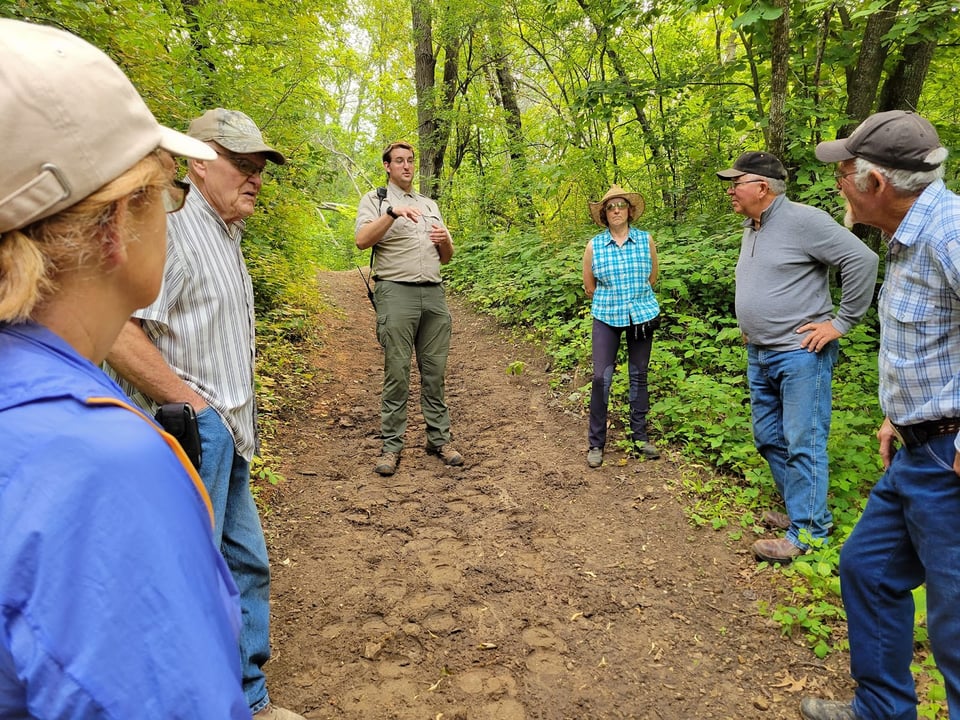
The Hay Creek walk. / Photo by Pamela Miller
On Saturday, July 15, Jake Gaster, our energetic, witty, wise and impressively tall Frontenac State Park head ranger (that’s him in the middle of the photo above), led a walk in the Hay Creek Management Unit, an area in northern Goodhue County managed by Frontenac State Park staff.
It wasn’t your routine nature walk; Jake was there to talk about the complexities of trail creation and upkeep. Now, by no means is this a dull – or uncontroversial – subject. Many of the good folks who joined the walk were members of a backwoods horse-trail group who are chomping at the bit (so to speak) to volunteer to help maintain the Hay Creek trails. But they’re limited in what they can do by state/DNR liability rules.
That made for some honest, sometimes frustrated conversations about trail management that ended in all agreeing that the status quo situation could be much better. Kudos to trail walkers and Jake for their thoughtful contributions to the conversation!
A boreal chorus frog. / Photo by Carol Hall, Minnesota DNR
Poem of the month
“Peepers”
By Ted E. Tollefson, Old Frontenac resident
Peepers have returned to the margins of Frontenac
as the Old River rises
and submerges most of what we call "beach"
like a choir of amphibious monks
these wee singers fill every nook and cranny
with a sound as timeless as ever-returning Spring:
there's room in it and around it
for early-arriving warblers, chickadees and even crows
a few woodpeckers provide a staccato clacking
that calls even reluctant mediators to attention
which is given and received as freely
as river and sand playing hide and seek.
In this tumbling river of sound
habits of separation can rest
and for few moments
that feel like forever
we are joined in a single wave of harmony
that washes away habits of I, me and mine
and leaves in its place
a field of wild abandon.
May the chorus of praise resound
and fill every cup and every ear
with this singular pulsating joy…
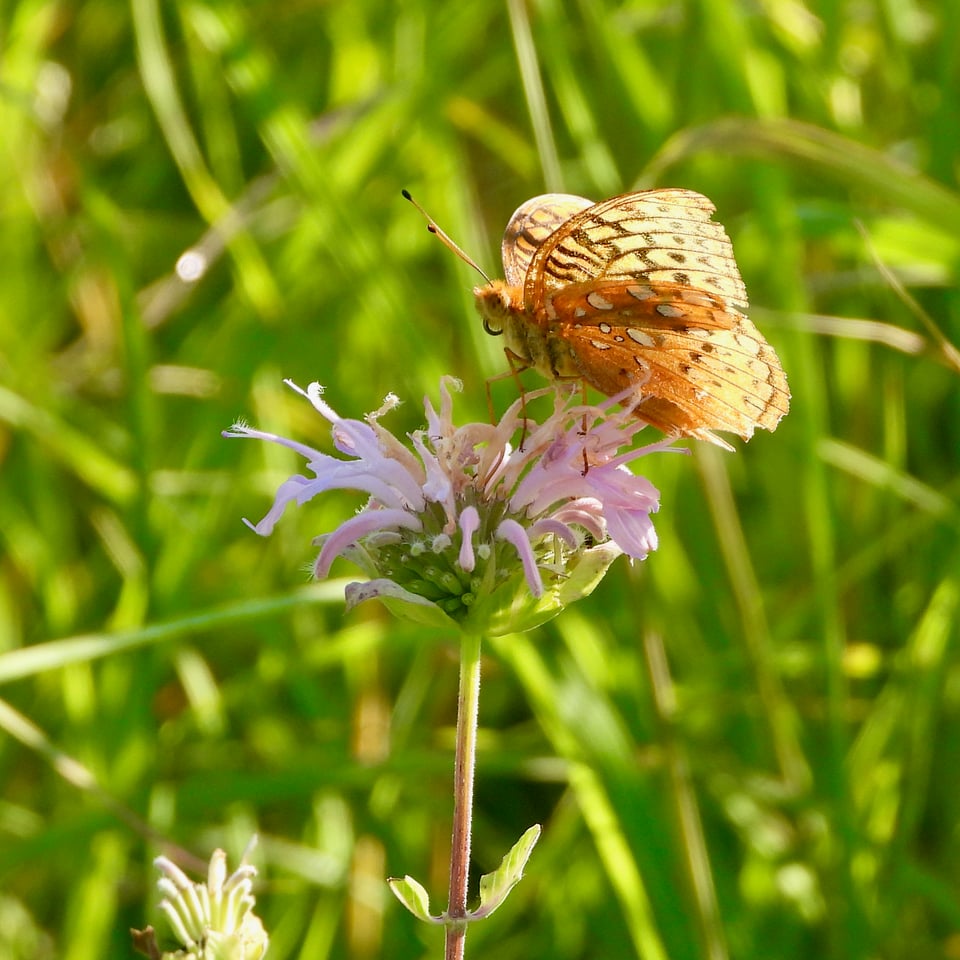
A great spangled fritillary visiting a wild bergamot on the Frontenac State Park prairie. / Photo by Steve Dietz
What are YOUR favorite park sites and sights?
🌿We love telling you about our favorite things in Frontenac State Park. What are yours? We’d love to hear from you about your most treasured park sites, sights and experiences. Send your stories and photos to us at pamelamarianmiller@gmail.com and we’ll include some in future newsletters!
Interested in joining the Frontenac State Park Association?
We’d love to have your support (dues are $25 per year for an individual, $30 for a couple). Here is a link.
And coming occasionally to help out with volunteer efforts is awesome too, even if you’re not a member. The FSPA’s goal is simply to share our love of Frontenac State Park with as many people as possible.
To sign up to regularly receive this monthly newsletter, click on “Subscribe” below, and if you have questions or comments about it, email your newsletter editor at pamelamarianmiller@gmail.com. Questions about the FSPA? You can reach FSPA chair Steve Dietz at stevedietz@duck.com.
This newsletter is edited and largely written by FSPA member Pamela Miller. This month, other contributing writers, editors and photographers included Janet Malotky, Steve Dietz and Carol Hall.
Handy links for more information and education
Frontenac State Park website
Frontenac State Park Association website
If you take pictures in the Park, tag us on Instagram
Frontenac State Park bird checklist
Frontenac State Park on iNaturalist
Parks & Trails Council
Website for our township, Florence Township
Minnesota Master Naturalist program
Red Wing Environmental Learning Center
Lake City Environmental Learning Program on FB
Frontenac State Park staff
Jake Gaster, park manager; Amy Jay, assistant park manager; Amy Poss, lead field worker
Thank you, readers and park visitors!
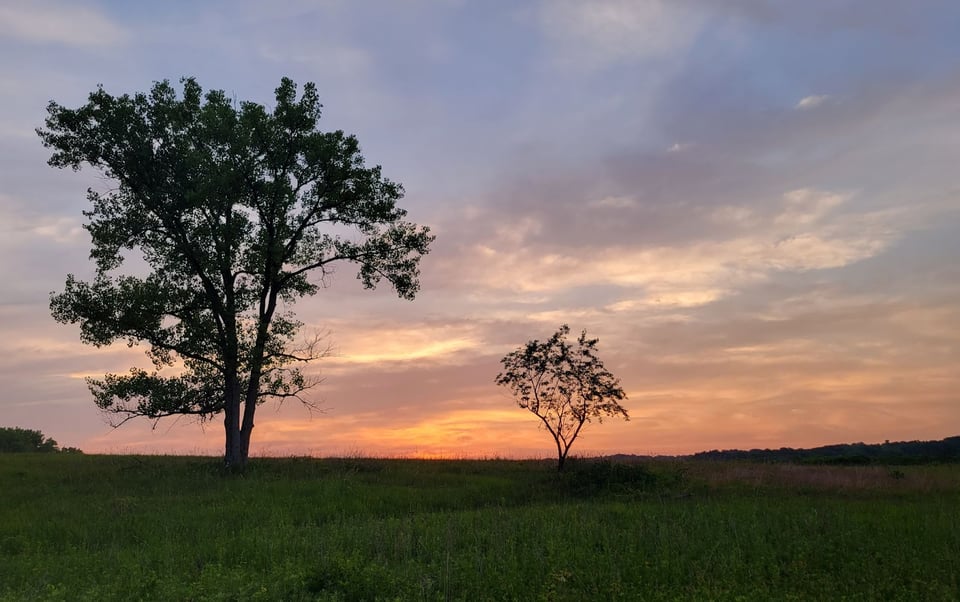
Parting shot: The sun sets on a smoky day in Frontenac State Park’s Prairie Loop Trail. Canadian wildfires have led to several smoky summer days in our area. / Photo by Pamela Miller
